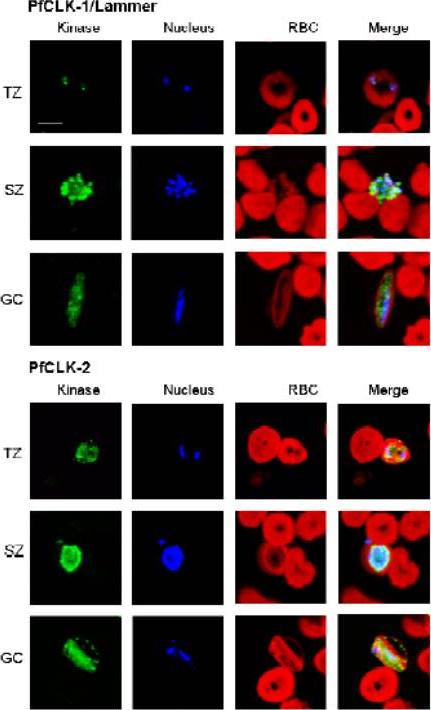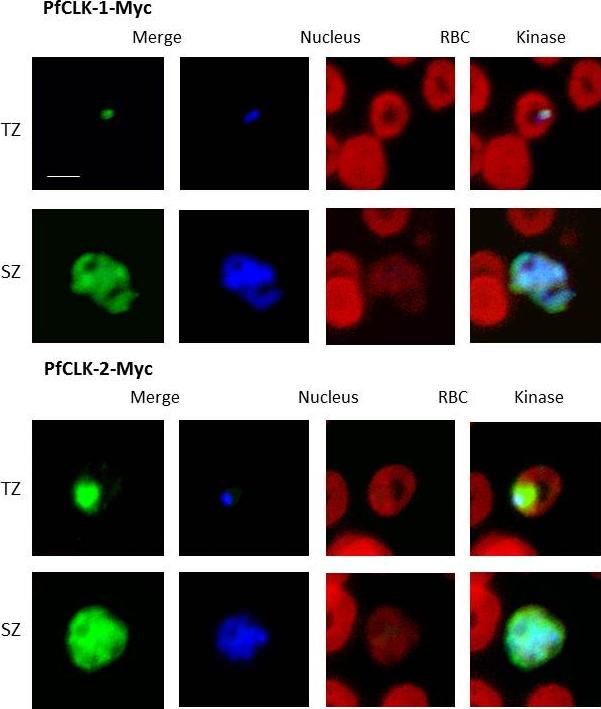PF3D7_1445400 protein serine/threonine kinase-1 (CLK1)
Disruptability [+]
| Species | Disruptability | Reference | Submitter | |
|---|---|---|---|---|
| P. falciparum 3D7 |
Refractory |
22127061 | Theo Sanderson, Wellcome Trust Sanger Institute | |
| P. falciparum 3D7 |
Refractory |
USF piggyBac screen (Insert. mut.) | USF PiggyBac Screen | |
| P. berghei ANKA |
Refractory |
RMgm-561 | Imported from RMgmDB | |
| P. berghei ANKA |
Refractory |
PlasmoGEM (Barseq) | PlasmoGEM | |
Mutant phenotypes [+]
None reported yet. Please press the '+' button above to add one.Imaging data (from Malaria Metabolic Pathways)

Blood stage-specific PfCLK expression and co-localization with the parasite nucleus. Indirect immunofluorescence assay using anti-PfCLK-1antibody showed distinct punctate protein expression in association with the nucleus of trophozoites (TZ) and schizonts (SZ). In gametocytes (GC) PfCLK-1expression was not restricted to the nucleus, but also present in the cytoplasm. PfCLK-2 was present in nucleus and cytoplasm of asexual parasites and gametocytes. In gametocytes, an additional labelling of the erythrocyte hem in a punctate pattern was observed. Kinase labelling was visualized with AlexaFluor488 secondary antibody (green), nuclei were highlighted by Hoechst staining (blue), red blood cells (RBC) were counterstained with Evans Blue (red). Bar, 5 μm. Agarwal S, Kern S, Halbert J, Przyborski JM, Baumeister S, Dandekar T, Doerig C, Pradel G. Two nucleus-localized CDK-like kinases with crucial roles for malaria parasite erythrocytic replication are involved in phosphorylation of splicing factor. J Cell Biochem. 2011 112(5):1295-310
See original on MMP
Upper two rows: Ultrastructural localization of PfCLKs in the parasite blood stages. Post-embedding immunoelectron microscopy labelling was performed using mouse antisera against PfCLK-1 and PfCLK-2, respectively, in combination with secondary gold-conjugated antibody. A: PfCLK-1/Lammer is predominantly present in the nucleus of a blood stage schizont. B: A distinct labelling of PfCLK-1 in the passage between nucleus and cytoplasm (arrow) was detected in another schizont. C: PfCLK-2 is expressed in the nucleus as well as the cytoplasm of a late trophozoite. D: PfCLK-2 labelling was particularly detected in the passage between nucleus and cytoplasm (arrows) of a schizont. E, erythrocyte; FV, food vacuole; MC, Maurer´s cleft; N, nucleus; PC, parasite cytoplasm; R, rhoptry. Bar, 0.5 μm. Lower row: Expression of Myc-tagged PfCLKs in blood stages. Post-embedding immunoelectron microscopy labelling was performed using anti-Myc antibody in combination with secondary gold-conjugated antibody. PfCLK-1/Lammer-Myc is predominantly present in the nucleus of a trophozoite. PfCLK-2-Myc can be detected in the nucleus and the cytoplasm of a schizont. E, erythrocyte; HZ, hemozoin; N, nucleus; PC, parasite cytoplasm. Bar, 0.5 μm.Agarwal S, Kern S, Halbert J, Przyborski JM, Baumeister S, Dandekar T, Doerig C, Pradel G. Two nucleus-localized CDK-like kinases with crucial roles for malaria parasite erythrocytic replication are involved in phosphorylation of splicing factor. J Cell Biochem. 2011 112:1295-310.
See original on MMP
Expression of Myc-tagged PfCLKs in blood stages. Indirect immunofluorescence assay using anti-Myc antibody showed a distinct punctate protein expression of PfCLK-1-Myc in association with the nucleus of trophozoites (TZ) and schizonts (SZ). PfCLK-2-Myc localizes in the nucleus and cytoplasm of blood stage parasites. Kinase labelling was visualized with AlexaFluor488 secondary antibody (green), nuclei were highlighted by Hoechst staining (blue), red blood cells (RBC) were counterstained with Evans Blue (red). Bar, 5 μm. Immunofluorescence assay on methanol-fixed mutants, using anti-Myc antibody, showed punctate expression of PfCLK-1-Myc in the nuclei of trophozoites and schizonts, while PfCLK-2-Myc was present in the nuclei and the cytoplasm of blood stagesAgarwal S, Kern S, Halbert J, Przyborski JM, Baumeister S, Dandekar T, Doerig C, Pradel G. Two nucleus-localized CDK-like kinases with crucial roles for malaria parasite erythrocytic replication are involved in phosphorylation of splicing factor. J Cell Biochem. 2011 112:1295-310.
See original on MMPMore information
| PlasmoDB | PF3D7_1445400 |
| GeneDB | PF3D7_1445400 |
| Malaria Metabolic Pathways | Localisation images Pathways mapped to |
| Previous ID(s) | PF14_0431 |
| Orthologs | PBANKA_1309200 , PCHAS_1312400 , PKNH_1236900 , PVP01_1261600 , PVX_118220 , PY17X_1313000 |
| Google Scholar | Search for all mentions of this gene |